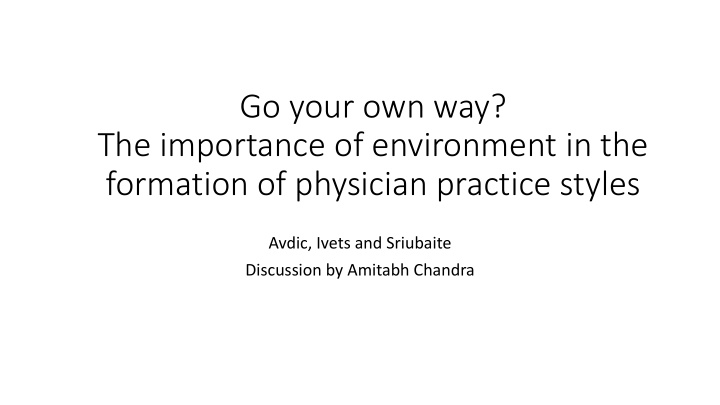



Go your own way? The importance of environment in the formation of physician practice styles Avdic, Ivets and Sriubaite Discussion by Amitabh Chandra
Highest Performance Lowest Performance Source: Chandra, Staiger and Skinner (IOM, 2010)
Stents are Highly Cost-Effective for some Marginal Benefit from Treatment Primary PCI Cost per PCI Stable Angina # Patients
But less so for the marginal patient Marginal Benefit from Treatment Cost per PCI Total Cost # Patients X’
Small Differences in Beliefs have large cost-implications Marginal Benefit from Treatment Different beliefs about benefits Cost per PCI Total Cost # Patients X Z
The New Yorker 1950-55 Collection “By all means, dear – buy it if you really want it. We’ll find the money for it somehow”
Average who say yes: 57%
Our Enterprise • Are Physician Factors Independent of Hospital/Environment factors? • What is the mechanism behind differences in physician factors • Peers versus capacity? • Peers versus environment? • Peers versus training? • Peer versus beliefs? • Is there heterogeneity across physicians in these factors? • What is the impact of this variation on patient outcomes?
Id Identification ∆ j =Time-invariant difference between a migrating cardiologist’s origin ( O ) and destination ( D ) hospitals’ risk -adjusted cath rates Using data on dates and peers, can be redefined as difference between a migrating cardiologist’s peers in origin and destination Diff-in-Diff : How much does a physician change her practice style after migrating? Coefficient of 1 means that 1 pp change in physician’s environment corresponds to a 1 pp change in physician behavior
Three suggestions • Approximately 160 cardiologists per year and 40 movers per year. So lots of noise in CATH rates • Even more noise in difference in CATH rates (subtracting signal+noise from signal + noise = noise) • Maybe use empirical bayes for shrinkage • Not sure whether peer effects are genuine peer effects or something else- maybe downplay these or show that they have variation above and beyond hospital level variation • Use simple theory to help understand null results on patient outcomes
Predictions of Hospital 30-day AMI Mortality, 2000 Example Empirical Bayes predictions of hospital mortality rate in 2000, accounting for volume and drift, using data from 1992-1999 & 2003-2013 13 Hospital Closures and Patient Mortality
Prototypical Roy Model of Treatment How one gets treated depends on X’s, hurdle, TFP and comparative advantage
15
Recommend
More recommend